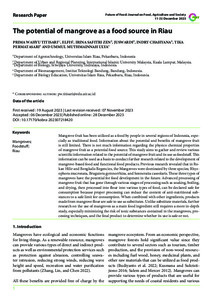| dc.date.accessioned | 2024-02-27T11:41:31Z | |
| dc.date.available | 2024-02-27T11:41:31Z | |
| dc.date.issued | 2023-12-28 | |
| dc.identifier | doi:10.17170/kobra-202307218420 | |
| dc.identifier.uri | http://hdl.handle.net/123456789/15497 | |
| dc.language.iso | eng | |
| dc.rights | Namensnennung 4.0 International | * |
| dc.rights.uri | http://creativecommons.org/licenses/by/4.0/ | * |
| dc.subject | mangroves | eng |
| dc.subject | foodstuff | eng |
| dc.subject | Riau | eng |
| dc.subject.ddc | 300 | |
| dc.subject.ddc | 500 | |
| dc.title | The potential of mangrove as a food source in Riau | eng |
| dc.type | Aufsatz | |
| dcterms.abstract | Mangrove fruit has been utilized as a food by people in several regions in Indonesia, especially as traditional food. Information about the potential and benefits of mangrove fruit is still limited. There is not much information regarding physico-chemical properties of mangrove fruit as a potential food source. This study aims to gather and review various scientific information related to the potential of mangrove fruit and its use as foodstuff. This information can be used as a basis to conduct further research related to the development of mangrove-based food and functional food products. Previous research revealed that in Rokan Hilir and Bengkalis Regencies, the Mangroves were dominated by three species; Rhyzophora mucronata, Bruguiera gymnorrhiza, and Sonneratia caseolaris. These three types of mangroves have the potential for food development in the future. Advanced processing of mangrove fruit that has gone through various stages of processing such as soaking, boiling, and drying, then processed into flour into various types of food, can be declared safe for consumption because proper processing can reduce the content of anti-nutritional substances to a safe limit for consumption. When combined with other ingredients, products made from mangrove flour are safe to use as substitutes. Unlike substitute materials, further research on the use of mangroves as a main food ingredient still requires a more in-depth study, especially minimizing the risk of toxic substances contained in the mangroves, processing techniques, and the final product to determine whether its use is safe or not. | eng |
| dcterms.accessRights | open access | |
| dcterms.creator | Titisari, Prima Wahyu | |
| dcterms.creator | Elfis | |
| dcterms.creator | Zen, Irina Safitri | |
| dcterms.creator | Juswardi | |
| dcterms.creator | Chahyana, Indry | |
| dcterms.creator | Sari, Tika Permata | |
| dcterms.creator | Ulya, Ummul Muthmainnah | |
| dc.subject.swd | Indonesien | ger |
| dc.subject.swd | Provinz Riau | ger |
| dc.subject.swd | Mangrove | ger |
| dc.subject.swd | Lebensmittel | ger |
| dc.subject.swd | Physikalisch-chemische Eigenschaft | ger |
| dc.type.version | publishedVersion | |
| dcterms.source.identifier | eissn:2197-411X | |
| dcterms.source.issue | No. 5 | |
| dcterms.source.journal | Future of Food: Journal on Food, Agriculture & Society | eng |
| dcterms.source.volume | Vol. 11 | |
| kup.iskup | false | |
| dcterms.source.articlenumber | 656 | |


